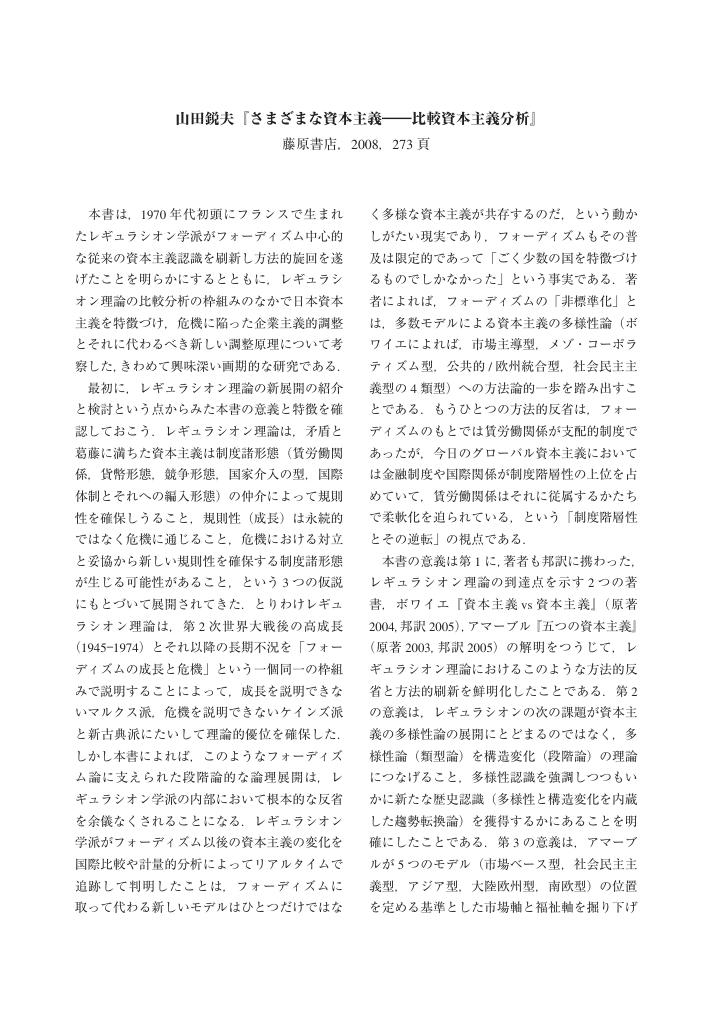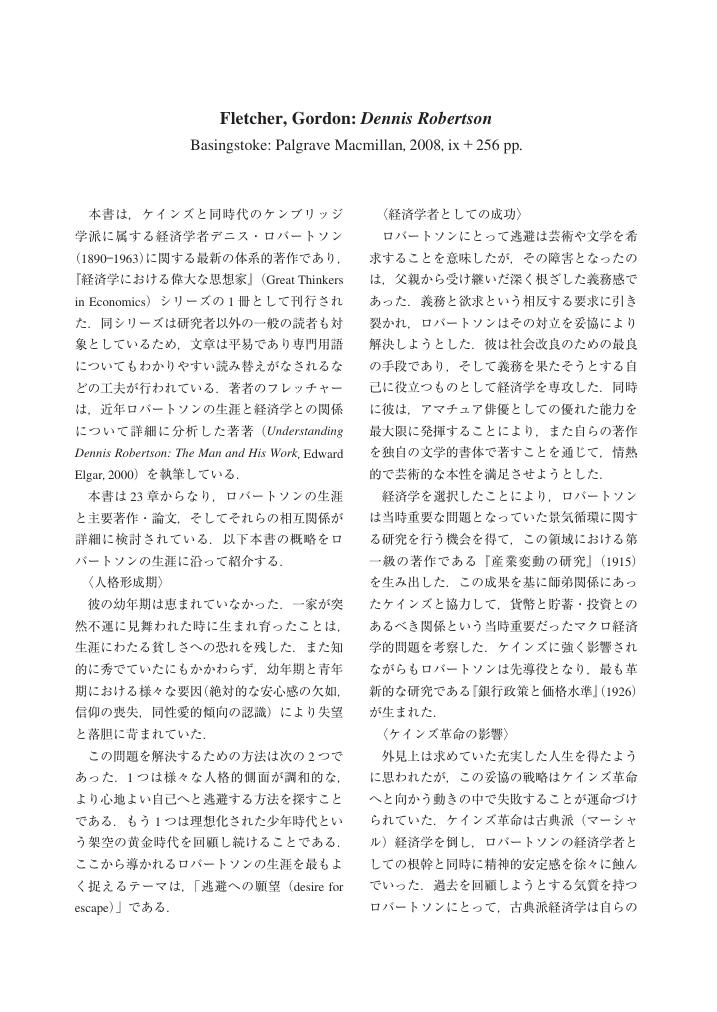1 0 0 0 OA 山田鋭夫『さまざまな資本主義―比較資本主義分析』 藤原書店,2008,273 頁
- 著者
- 若森 章孝
- 出版者
- 経済学史学会
- 雑誌
- 経済学史研究 (ISSN:18803164)
- 巻号頁・発行日
- vol.51, no.2, pp.124-125, 2009 (Released:2019-08-08)
1 0 0 0 OA 山本英司『カレツキの政治経済学』 千倉書房,2009,228 頁
- 著者
- 元木 久
- 出版者
- 経済学史学会
- 雑誌
- 経済学史研究 (ISSN:18803164)
- 巻号頁・発行日
- vol.51, no.2, pp.126-127, 2009 (Released:2019-08-08)
- 著者
- 石原 俊時
- 出版者
- 経済学史学会
- 雑誌
- 経済学史研究 (ISSN:18803164)
- 巻号頁・発行日
- vol.51, no.2, pp.128-129, 2009 (Released:2019-08-08)
- 著者
- 西岡 幹雄
- 出版者
- The Japanease Society for the History of Economic Thought
- 雑誌
- 経済学史研究 (ISSN:18803164)
- 巻号頁・発行日
- vol.52, no.1, pp.1-19, 2010 (Released:2019-08-20)
- 被引用文献数
- 1 1
Abstract: Dazai Shundai (1680―1747) associated the problem of the interest in people’s welfare by creating useful means for which they enriched their lives with institutionalization processes of political economy in the early eighteenth-century Japan. He meant that the purpose of public welfare-to cause stability and prosperity of the community and people’s lives in general-was established as a part of practical learning, through institutionalization. This offered a practical approach to rationality. Dazai linked “the road to public welfare by interests” with the management of the state and human relief. When he attempted to discuss the problem of the ‘the law of joheiso’ as an institutional framework, on the basis of the theme of public welfare of people by interest, his philosophy of political economy contained a systematic design for welfare and economy. This included the manner in which a solution that loses touch with private interests is able to adjust “the world and the nation” as external public interests. However, Dazai’s conclusion was unable to absorb in a unilateral manner the frame cost in order to advance institutionalization, and would overload public welfare. Before creating an institutional design, what can morality in the social climate constitute in the institutional performance among incentive structures? The activation, based on moral recognition, widely needed the foundation of the institutional design for public welfare and its spillover effect. In this sense, Dazai’s image of humankind was that of an uncooperative situation, which was due to his belief that people were unable to be endogenous in their learning function. JEL classification numbers: B 11, H 11, N 35.
1 0 0 0 OA 市場・貧困・統治 18世紀末から1830年代のフランスにおける政治経済学
- 著者
- 田中 拓道
- 出版者
- 経済学史学会
- 雑誌
- 経済学史研究 (ISSN:18803164)
- 巻号頁・発行日
- vol.52, no.1, pp.20-34, 2010 (Released:2019-08-20)
The purpose of this article is to examine the changes in the role played by the government in the market according to the theories of the French political economy from the 1780s to the 1830s. These theories are generally regarded as the precursors of “economics.” This article reveals that these theories attempt to use the market politically aiming to develop the people’s “well-being” or “happiness,” and to redefine the government’s role in the market. At the beginning of nineteenth century, J. B. Say and C. Dunoyer emphasized the political significance of a free industrial market. According to them, it enables the people’s “moeurs” to be independent and self-disciplined, so as to establish a post-revolutionary political order. Some contemporary political economists such as J. Droz and M. T. Duchâtel doubted the compatibility between the accumulation of wealth and the development of “happiness” of the people. They asserted the need for elementary education as it leads to the redistribution of “new wealth.” Moreover, social economists from the 1830s, such as A. de Villeneuve- Bargemont and E. Buret, emphatically discussed the perverse effect of industrialization, stating that the concentration of capital inevitably caused the pauperization of most of the people. They believed that the new role of the government should be the “moralization” of the poor through the organization of intermediate groups such as religious associations, saving associations, charity groups, mutual societies, and patriarchal families. JEL classification numbers: B 25, B 31
1 0 0 0 OA カール・メンガーの論理 『国民経済学原理』から方法論争へ
1 0 0 0 OA ウィリアム・カップの科学統合論と累積的因果関係論
- 著者
- 山根 卓二
- 出版者
- 経済学史学会
- 雑誌
- 経済学史研究 (ISSN:18803164)
- 巻号頁・発行日
- vol.52, no.1, pp.50-66, 2010 (Released:2019-08-20)
This paper aims to study the characteristics of the principles of Karl William Kapp’s cumulative causation. While Kapp’s cumulative causation is strongly influenced by that of Gunnar Myrdal, it is not a model that merely explains disequilibrium or the “vicious circle” phenomena. Kapp was always interested in constructing a model that addresses issues arising from the compartmentalization of modern sciences. Therefore, his critique of mainstream economics should be understood in this context. Kapp argued that the approaches of mainstream economics were misleading because they isolated economic systems from non-economic elements. According to him, the trend toward the compartmentalization of mainstream economics could be inhibited by employing a cumulativecausation approach. Kapp’s institutional economics, which integrates cumulative causation, is an approach that refutes the atomistic views of the world proposed by mainstream economics. Through these atomistic views, individuals regarded as eternal; however, Kapp’s approach regards them as transient phenomena appearing in holistic dynamic processes. Furthermore, his approach shows that a human being is an existence with a multi-level construction. A human being is a “bio-cultural” existence that grows physically and personally, incorporating material and energy from nature, and culture from the society. Some societies ignore the latent ability of their members and attempt to limit them to the mould of a particular culture. Kapp described this aspect by means of principles of cumulative causation. JEL classification numbers: B 25, B 31, Q 50.
- 著者
- 下平 裕之
- 出版者
- 経済学史学会
- 雑誌
- 経済学史研究 (ISSN:18803164)
- 巻号頁・発行日
- vol.51, no.2, pp.106-107, 2009 (Released:2019-08-08)
1 0 0 0 OA 岩下伸朗『マーシャル経済学研究』 ナカニシヤ出版,2008,xiv+315 頁
- 著者
- 礒川 曠
- 出版者
- 経済学史学会
- 雑誌
- 経済学史研究 (ISSN:18803164)
- 巻号頁・発行日
- vol.51, no.2, pp.108-109, 2009 (Released:2019-08-08)
- 著者
- 松永 友有
- 出版者
- 経済学史学会
- 雑誌
- 経済学史研究 (ISSN:18803164)
- 巻号頁・発行日
- vol.51, no.2, pp.110-111, 2009 (Released:2019-08-08)
- 著者
- 竹永 進
- 出版者
- 経済学史学会
- 雑誌
- 経済学史研究 (ISSN:18803164)
- 巻号頁・発行日
- vol.51, no.2, pp.112-113, 2009 (Released:2019-08-08)
1 0 0 0 OA 佐藤方宣 編『ビジネス倫理の論じ方』 ナカニシヤ出版,2009,vii+282 頁
- 著者
- 井上 義朗
- 出版者
- 経済学史学会
- 雑誌
- 経済学史研究 (ISSN:18803164)
- 巻号頁・発行日
- vol.51, no.2, pp.114-115, 2009 (Released:2019-08-08)
- 著者
- 山崎 聡
- 出版者
- 経済学史学会
- 雑誌
- 経済学史研究 (ISSN:18803164)
- 巻号頁・発行日
- vol.51, no.2, pp.116-117, 2009 (Released:2019-08-08)
- 著者
- 柳沢 哲哉
- 出版者
- 経済学史学会
- 雑誌
- 経済学史研究 (ISSN:18803164)
- 巻号頁・発行日
- vol.51, no.2, pp.118-119, 2009 (Released:2019-08-08)
1 0 0 0 OA 根岸 隆『経済学の理論と発展』 ミネルヴァ書房,2008,vi+296 頁
- 著者
- 千賀 重義
- 出版者
- 経済学史学会
- 雑誌
- 経済学史研究 (ISSN:18803164)
- 巻号頁・発行日
- vol.51, no.2, pp.120-121, 2009 (Released:2019-08-08)
- 著者
- 若田部 昌澄
- 出版者
- The Japanease Society for the History of Economic Thought
- 雑誌
- 経済学史研究 (ISSN:18803164)
- 巻号頁・発行日
- vol.51, no.2, pp.18-32, 2009 (Released:2019-08-08)
- 参考文献数
- 49
This paper proposes a way to understand the evolution of macroeconomic thinking. The macroeconomic thinking, not necessarily synonymous with macroeconomics, has been dealing with the questions of money and business cycles. Money and business cycles, in turn, have been closely connected with the international monetary arrangements such as the Gold Standard, the Bimetallic Standard, the Bretton Woods system, and the Flexible Exchange Rate. I shall argue that the evolution of macroeconomic thinking is best understood as the responses of economists to, and their interaction with, the changing monetary and exchange rate regimes. The theoretical foundation of the paper is rather simple: the so-called trilemma, or “irreconcilable or impossible trinity.” A policymaker cannot simultaneously choose a fixed exchange rate, free mobility of capital, and domestic price stability via independent monetary policy. Facing this constraint, the policymaker can, at most, choose two from among these three goals. Therefore, further questions emerge: which goal or goals should be given priority from among these three, and what is the exact tool or mechanism that can ensure the achievement of preset policy goals. The answer to the first question determines the nature of international monetary arrangements, which, in turn, are shaped by political and economic factors. With respect to the second issue, institutions, or what we might call the institutional or social governance technology, play a crucial role. Throughout history, concerns over “unrestrained inflation” have been widespread, since there have always been strong incentives for a government to raise seigniorage by over-issuing money. The choice of international monetary arrangements depends on the availability, credibility, and effectiveness of a specific social governance technology that acts as a constraint upon policymakers, which, in turn, depend on the specific political and economic structure. JEL classification numbers: B 20, B 22, E 42.
1 0 0 0 OA カール・ポランニーの「経済社会学」の誕生 『大転換』から『人間の経済』へ
- 著者
- 若森 みどり
- 出版者
- 経済学史学会
- 雑誌
- 経済学史研究 (ISSN:18803164)
- 巻号頁・発行日
- vol.51, no.2, pp.33-50, 2009 (Released:2019-08-08)
- 参考文献数
- 50
1 0 0 0 OA A. マーシャルにおける心理学研究と経済学との連関
- 著者
- 松山 直樹
- 出版者
- 経済学史学会
- 雑誌
- 経済学史研究 (ISSN:18803164)
- 巻号頁・発行日
- vol.51, no.2, pp.51-67, 2009 (Released:2019-08-08)
- 参考文献数
- 59
1 0 0 0 OA Beyond Walras
- 著者
- 塘 茂樹
- 出版者
- The Japanease Society for the History of Economic Thought
- 雑誌
- 経済学史研究 (ISSN:18803164)
- 巻号頁・発行日
- vol.51, no.2, pp.84-93, 2009 (Released:2019-08-08)
- 参考文献数
- 28
1 0 0 0 OA 『経済思想』(全11 巻,日本経済評論社,2004―07 年)に学ぶ
- 著者
- 中村 廣治
- 出版者
- 経済学史学会
- 雑誌
- 経済学史研究 (ISSN:18803164)
- 巻号頁・発行日
- vol.51, no.2, pp.94-101, 2009 (Released:2019-08-08)















